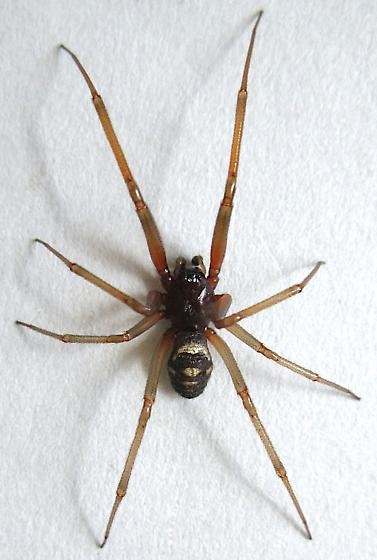Advice for the Home Gardener from the Help Desk of the
UC Master Gardener Program of Contra Costa County

Copyright © 2016 Jim Moore
@ bugguide.net
MGCC Help Desk Response: Thank you for contacting the UC Master Gardeners Program Help Desk. Your picture does appear to be a false widow spider (Steatoda grossa). Steatoda grossa, is not a true widow spider; however, it is in the same family, Theridiidae, as widow spiders and can easily be confused with them. It shares the same rounded-abdomen body form and web-making traits. It is usually slightly smaller than a mature western black widow spider body (length: 3/8 inch), chocolate brown in color, and never has red coloration on its belly.
I was unable to find UC information that considers this spider to be an invasive pest potentially harming native flora or fauna. However, the false black widow is a European immigrant (as is the true black widow) that has become extremely common in Pacific Coast homes (vs. outdoors) from San Diego to British Columbia, with isolated finds in Alaska. Unlike black widows, false black widow spiders thrive indoors, especially in washrooms, inside cupboards and underneath appliances, furniture, and cabinets. So, it's probably a good thing that yours is outside where it does like to feed upon various garden bugs trapped in their webs!
The false widow is reported to capture and prey upon other spiders, including true black widow spiders.
Usually timid and non-aggressive, they will bite if threatened. Their venom is mild compared to a black widow - bites may cause symptoms similar to those of yellow jacket wasp stings: initial burning pain followed by minor localized swelling around the bite site.
Our advice would be to leave the spider where it is unless you are uncomfortable with its location or worried about being bitten.
Various insecticides are registered for control of spiders; including pyrethrins, pyrethroids, and combinations of these products. Vacuuming also works and it isn't toxic!
Please let us know if you have any further questions and again, thank you for contacting our office.
Help Desk of the UC Master Gardener Program of Contra Costa County (JMA)
Please Join us at "Fall for Plants" on September 9 for the workshops and the plant sale,.
Registration is optional, but it'll get you a free plant from the sale. Hope to see you there.
Note: The UC Master Gardeners Program of Contra Costa's Help Desk is available year-round to answer your gardening questions. Except for a few holidays, we're open every week, Monday through Thursday for walk-ins from 9:00 am to Noon at 75 Santa Barbara Road, 2d Floor, Pleasant Hill, CA 94523. We can also be reached via telephone: (925)646-6586, email: ccmg@ucanr.edu, or on the web at http://ccmg.ucanr.edu/Ask_Us/ MGCC Blogs can be found at http://ccmg.ucanr.edu/HortCoCo/ You can also subscribe to the Blog (//ucanr.edu/blogs/CCMGBlog/).